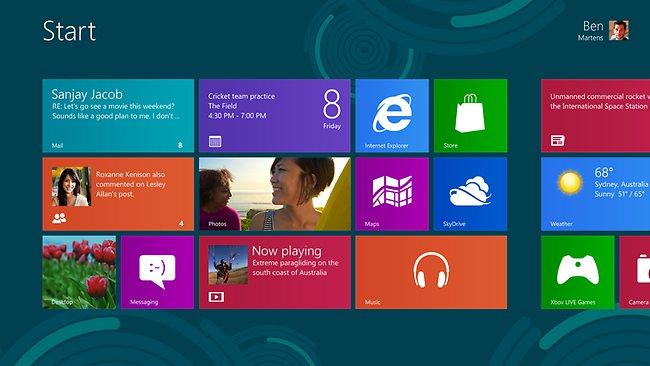Open Windows into another world
STRAP yourself in. Windows 8 is not a small change.

STRAP yourself in. Windows 8 is not a small change.
More than 90 per cent of the world's computers use Microsoft's Windows operating system, with most running on the recently released Windows 7 or the more distantly issued Windows XP.
But when you compare those two software packages side by side, they don't look dissimilar.
Windows 8, on the other hand, looks like their distant cousin, twice-removed and sent from the future.
Go to the home page and you won't see a Start button, you won't spot a taskbar, and you might fail to spy anything resembling an icon as you know it.
Even the menus are hidden in this operating system: you have to know where to touch or point to even see them.
In short, Windows 8 represents one of the rare cases where even IT professionals may need to read a manual. All is not lost, however, it's just found in a different way, and users will need to adjust.
WHAT'S NEW
The most noticeable change to Windows 8 is its home screen.
The traditional taskbar, programs and smattering of icon shortcuts have been replaced by a screen of coloured boxes. Once called Metro, this look is now known by the less catchy phrase, Windows 8 User Interface.
While hard to name, it is a very attractive layout and delivers computer programs such as apps on a Windows Phone.
Traditional Microsoft programs such as Word, Outlook and Excel all receive tiles under the Office grouping, for example, while weather, Twitter and reading apps can be added to their own groups and moved around to different places in the sideways-scrolling line-up.
Another big feature of Windows 8 is its spotlight on apps. The Store shortcut delivers access to plenty of miniature programs for your computer, many of which are free.
Don't expect it to be as well populated as some other app repositories (big names including Facebook are still missing), but it's a handy way to boost your computer's usefulness.
WHAT'S MISSING
There's no need for the Rolling Stones song any more: this tablet has no Start button.
It's an immediately noticeable omission for any Windows user and it takes a while to adjust.
Microsoft appears to have removed Start very deliberately. Even in the Samsung Series 7 Slate PC's Desktop Mode that we tested, the button has been replaced by an Internet Explorer shortcut. Microsoft could have added it there for comfort, but it did not.
Finding menus is also likely to be tricky for newcomers, though they are only hiding and not missing.
Slide a finger or a mouse from the side of the screen and a five-option menu appears. Its shortcuts will take you to an open program, share what you're looking at, manage devices, open more settings or perform a search.
The search is perhaps the most useful feature of this Windows 8 menu as it can be used to find apps, settings and files, and will contextually change depending on what you have open at the time.
Settings is another useful part of this menu as, while it offers only few options, tapping Change PC Settings will deliver more.
SHORTCUTS
In most cases, Windows users won't use the same shortcuts they once did. Alt-Tab will still flip through your open programs, but Microsoft would prefer that you simply swept from one program to the other.
The Samsung Slate let us do this by dragging a finger from the left of the screen and, to its credit, Windows 8 flipped through programs rapidly.
To close a program, you must drag the top of it down. There are no close boxes outside desktop mode.
There are also other shortcuts worth noting in case you get stuck. Many are here: http://bit.ly/RhX0eM.
VERDICT
Microsoft is taking a massive risk on Windows 8 and there are benefits and drawbacks to its bet.
On the plus side, Windows 8 is a frisky, fast operating system that handles big programs with ease. Unlike Vista, it will also work on old hardware and can be downloaded for a small upgrade fee.
Its new look is also deeply attractive and anyone with a touchscreen computer, be it a tablet or an all-in-one, should appreciate its new tiles and touchy-feely appeal.
They will only appreciate those new features once they adapt, though, and Microsoft has not made it easy. The sheer learning curve involved in using Windows 8 is likely to turn off plenty of Windows users, their most committed and entrenched fans in particular.
Windows 8 is a bold change. If it pays off, it could take a while to do so.
